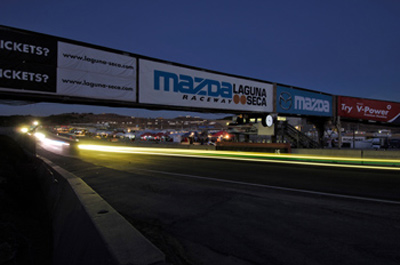October 25th 2006
Fifty Years Young
ALMS race at 50th anniversary of Laguna
Story by Michael T. Lynch
On Saturday October 21st, Mazda Raceway Laguna Seca hosted the American Le Mans Series as the featured race during the final weekend of the track�s fiftieth season. The result was spectacular. Under clear skies, with temperatures in the mid-seventies, four classes fought it out on what remains one of the country�s premier road courses after half a century of seeing practically every major driver and series race there at least once. Adding to the spectacle was Laguna CEO Gill Campbell and her staff�s visionary decision to time the race at the end of the day, so the cars took the start bathed in bright sunshine and finished in deep twilight, running with lights ablaze and the pits illuminated as at Le Mans, Daytona or Sebring.

As darkness falls, the cars continue to speed under the start/finish bridge at Mazda Raceway Laguna Seca. If there had been a scent of orange groves, it could have been my first visit to Sebring in 1956. Credit: Laguna Seca
|
The IMSA participants responded by putting on a show that saw three of the four classes with the first two cars in sight of each other after four hours of extremely exciting racing.
The Audi R10 in both gasoline and diesel form has proven itself over the years to be one of the greatest racing sports cars in history, and Laguna Seca completed a perfect year for them in IMSA, as they finished one-two overall. Both the Audi diesels lost a lap near the beginning of the race due to various mishaps including a collision. However, their superior fuel economy allowed them to make one less pit stop than their Zytek and Creation competition, giving them the victory. Audi won the LMP1 class in all ten races this season, winning overall in seven. Laguna Seca winners Dindo Capello and Alan McNish tied for the drivers� title, and Audi won the Team title. Capello may be the greatest driver North Americans haven�t heard of. This victory marked his twenty-third in ALMS competition, a record.

The winning Audi leads the Maassen /Bernhard Porsche RS Spyder entered by the Penske team. When Roger Penske drove a Porsche RSK in the late 1950s, his race number was also six. Some things never change. Credit: IMSA
|
In the LMP2 class, Roger Penske�s Porsche RS Spyders pulled off a high-odds scoring coup. Drivers Sacha Maassen and Lucas Luhr were teamed in the same Porsche earlier in the season, but were put into different cars with the plan to end up tied for Driver�s Championship points. The scheme worked, with Luhr and Romain Dumas finishing fourth, while teammates Maassen and Timo Bernhard were fifth, first and second in class and winning the season team prize.
The finale to a season-long donnybrook took place in the GT1 class where two Aston Martin DBR9s and a pair of Corvette C-6Rs duked it out for the entire afternoon. Victory finally went to the Pedro Lamy/Stephane Sarrazin Aston, to these eyes, the best looking car on the course. The four cars ran together most of the race, and the Johnny O�Connell/Ron Fellows Corvette actually passed the Sarrazin Aston with twenty-seven minutes to go, only to be repassed a couple of corners later. It was the Aston�s fifth victory of the season, but Corvette won both the Drivers� and Teams� Championships in class.

What race cars should look like. With color schemes redolent of the fifties and sixties, the two Aston Martin DBR9s run together at Laguna Seca. The GT1 class-winning Lamy/Sarrazin car leads. Credit: IMSA
|
Italian car enthusiasts were most closely concerned with the GT2 category, which features the Risi Ferrari 430 GT Berlinettas, presently Ferrari�s only meaningful presence in any major U.S.series. Former Ferrari F1 driver Mika Salo, teamed with Stephane Ortelli, put up a magnificent drive in the final stint, coming back from a 15 second stop and go penalty for �unavoidable contact�. With the crowd on their feet in the grandstands, and pressing against the fence in the gathering gloom all around the circuit, Salo took the class lead from the Jorg Bergmiester/Patrick Long Porsche 911 GT2 RSR with just ten minutes to go. The points involved gave the Risi Ferrari the season�s Team Championship. Salo summed up the feeling of many spectators at the end of a day of outstanding racing, �Running in ALMS was the high point. FIA GT is nowhere close. I�ve been doing both all year and I wish this was the main one. This is so much more fun and there is much more atmosphere. It�s a better championship.�

With the sun heading for the horizon, the Risi Ferrari 430 GT makes its final bid for the class win at Laguna Seca. Credit: Risi Ferrari
|
Fifty years ago, at the first feature race at Laguna Seca, Pete Lovely won in another Ferrari, a 500 Testa Rossa. Lovely still races here, in the Monterey Historic Automobile Races. I haven�t been able to reach Pete, but it�s doubtful that he thought Laguna Seca and Ferrari would both remain at the top of their game, fifty years later.

A competitor takes to the verge, trying to keep up with the class-winning Dumas/Luhr Porsche RS Spyder. Credit: Porsche
|
In a racing world dominated by spec cars, the ALMS provides a beacon for lovers of high technology cars that don�t all look alike. If you want to see sports car racing as it once was, with interesting cars and multiple classes in one race, take in an ALMS event next year. If you do it at Laguna Seca, you won�t be disappointed.



